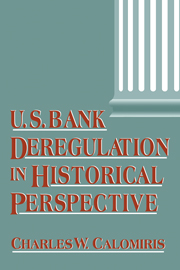Book contents
- Frontmatter
- Contents
- Acknowledgments
- Introduction
- 1 Regulation, industrial structure, and instability in U.S. banking: An historical perspective
- 2 The origins of banking panics: Models, facts, and bank regulation (with Gary Gorton)
- 3 The origins of federal deposit insurance (with Eugene N. White)
- 4 The costs of rejecting universal banking: American finance in the German mirror
- 5 The evolution of market structure, information, and spreads in American investment banking (with Daniel M. G. Raff)
- 6 Universal banking, “American style”
- General Index
- Index of Names
5 - The evolution of market structure, information, and spreads in American investment banking (with Daniel M. G. Raff)
Published online by Cambridge University Press: 11 September 2009
- Frontmatter
- Contents
- Acknowledgments
- Introduction
- 1 Regulation, industrial structure, and instability in U.S. banking: An historical perspective
- 2 The origins of banking panics: Models, facts, and bank regulation (with Gary Gorton)
- 3 The origins of federal deposit insurance (with Eugene N. White)
- 4 The costs of rejecting universal banking: American finance in the German mirror
- 5 The evolution of market structure, information, and spreads in American investment banking (with Daniel M. G. Raff)
- 6 Universal banking, “American style”
- General Index
- Index of Names
Summary
Introduction
The fees investment bankers earn for placing primary securities issued by their clients have occupied a central place in the debate over the proper regulation of investment banking since at least the beginning of the twentieth century. In his classic attack on the “money trust,” Other People's Money and How the Bankers Use It, Louis Brandeis argued that the enormous fees earned by investment bankers – particularly on stock issues – offered conclusive proof of the existence of substantial rent extraction by the “money trust.” Brandeis (1914, p. 95) noted that Morgan's gross commission (or “spread”) exceeded 20 percent for the organization of U.S. Steel and was 25 percent for underwriting the Tube Trust. More generally, Brandeis (p. 95) wrote:
Nor were monster commissions limited to trust promotions. More recently, bankers' syndicates have, in many instances, received for floating preferred stocks of recapitalized industrial concerns, one-third of all the common stock issued, besides a considerable sum in cash. And for the sale of preferred stock of well established manufacturing concerns, cash commissions (or profits) of from 7½ to 10 percent of the cash raised are often exacted. On bonds of high-class industrial concerns, bankers' commissions (or profits) of from 5 to 10 points have been common.
Brandeis considered it self-evident that such commissions could only be produced by an excessive concentration of power in the investment banking industry that gave rise to an effective monopoly over the financial market.
- Type
- Chapter
- Information
- U.S. Bank Deregulation in Historical Perspective , pp. 280 - 333Publisher: Cambridge University PressPrint publication year: 2000



